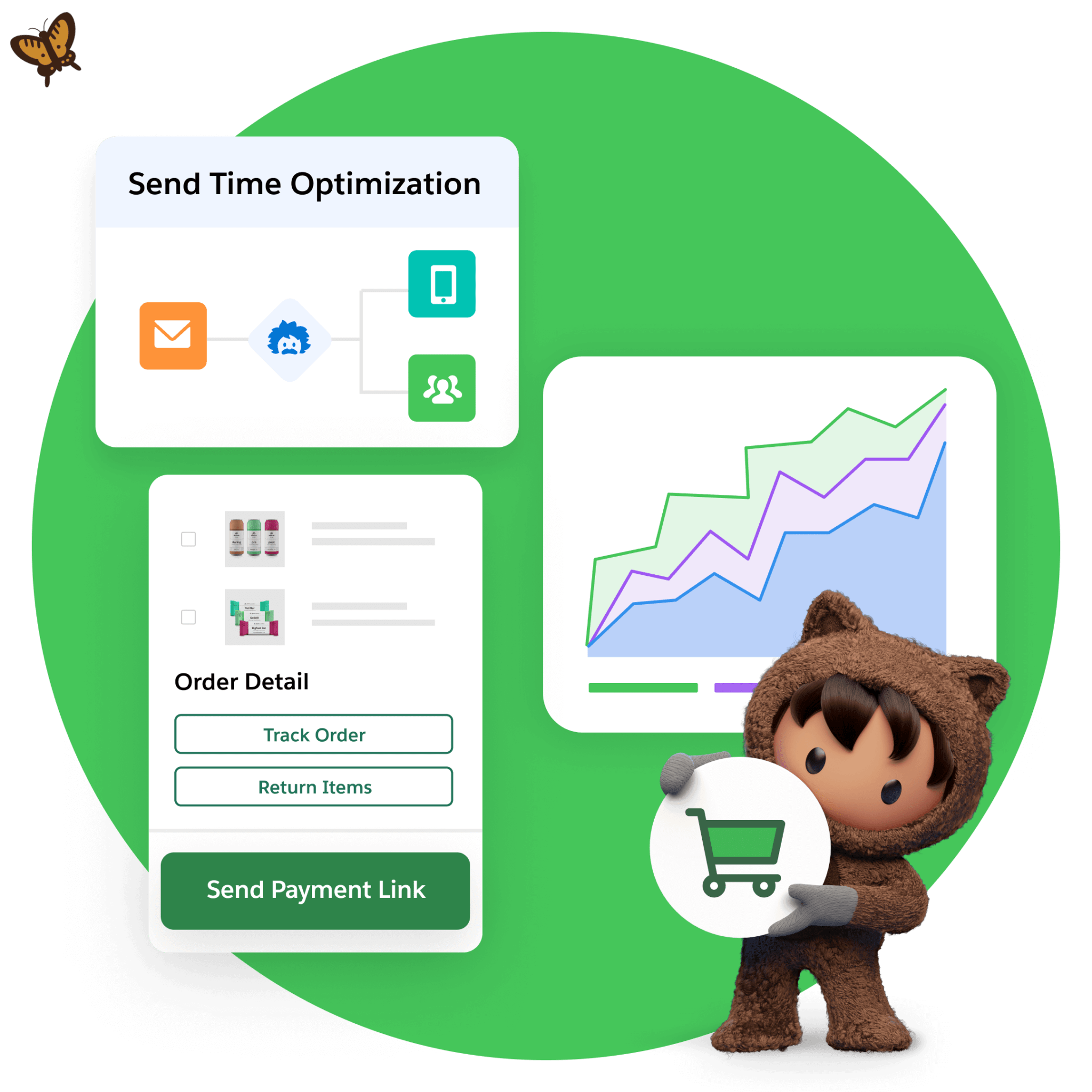Just as we all judge books by their covers (despite the saying), potential customers judge small and medium businesses (SMBs) by their storefronts. It’s a prime opportunity to stand out from the competition, and investing in thoughtful design can help build a foundation for sustained growth and customer acquisition. A well-designed storefront acts as an always-on marketing tool that engages your customers with experiences worth talking about.
So, whether you’re about to kick off your brand new online store, or you’re looking to optimize your storefront for more reach, these design tips can help you get inspired.
What you’ll learn:
- What is a digital storefront for small businesses?
- Ten design tips for small business storefronts
- Choosing the right platform for building a storefront
- Get more from your storefront with Salesforce
What is a digital storefront for small businesses?
Before you start designing, be sure to gather all the information you need to reach your customers online. Here are a few elements you’ll need to offer a seamless shopping experience:
A digital storefront is a place where small and growing businesses sell online, typically a website or a dedicated storefront platform. Think of it as a virtual store window that displays products or services to potential customers. A digital storefront helps small commerce businesses attract attention in an increasingly competitive space.
According to the latest Salesforce State of Commerce report, around 53% of consumers are choosing to engage digitally. Offering a memorable storefront experience can turn first-time buyers into long-term customers. Storefronts can build emotional connections with your customers when designed in a way that resonates. This is why design is such an important factor while building your online store.
Design components in a storefront to consider
- Website or storefront platform: Include your domain name on the site or platform you’re selling from.
- Brand logo and consistent visual identity: Consistently add visuals like logo, colors, and fonts to make your brand recognizable online to create a cohesive experience.
- Simple navigation menu: Offer a clear and intuitive menu that helps shoppers easily find what they want. This reduces confusion and frustration.
- Featured products: Highlight your best selling products or bundles as they can help grab customer attention and increase the average order value (AOV).
- Call-to-action (CTA) buttons: Add clear and compelling CTA buttons that guide shoppers toward desired actions, like “Add to Cart” or “Shop Now.”
- Mobile responsiveness: Ensure your store adapts seamlessly to all screen sizes to provide a uniform experience on any device.
- Product categories and filters: Offer well-organized categories and filters help customers narrow their choices and proceed to purchasing faster.
Sell More With Salesforce For Small Business
Pro tip: With Salesforce’s digital storefronts, you don’t even need a website to run your online store. It comes with multiple templates and can be integrated into your customer relationship management (CRM) tool. Digital storefronts are affordable and allow for design customizations to help you maintain consistency everywhere.

Ten design tips for small business storefronts
Whether you’re an avid designer or a first time tech user, these design tips will help you create an online experience that people won’t stop recommending:
1. Optimize your storefront layout
Your storefront thrives when designed with the customer journey in mind. With digital channels driving over 54% of revenue today, a mobile-friendly storefront becomes more crucial than ever. Optimizing your storefront to meet your customers’ expectations and evolving market needs shows that you respect their time and choices.
Here are a few ways to do this:
- Use high-quality, low-compression images: Use high-quality product images with consistent elements and designs that are compressed for page speed.
- Place best-sellers on display: Put your best-selling products and promotions in areas where they’re easily seen and clicked.
- Simplify menu navigation: Design an accessible menu that lets shoppers quickly browse product categories and find items without feeling overwhelmed.
- Test different layouts: A/B test different layouts, buttons, and content placements to understand what’s driving better results.
- Have a mobile-first approach: Offer a seamless experience on all devices as customers browse and shop from their phones and tablets.
Pro tip: Artificial intelligence (AI) tools can analyze customer behavior across your storefront and suggest ideal product placements and design layouts. AI can also pinpoint which CTAs or features are improving your conversion rates. Plus, insights like these can help you refine your ecommerce strategy.
2. Maintain design consistency with storefront templates
The easiest way to keep your branding consistent across your storefront is to use a template. Storefront templates can make SMB owners more efficient as they provide pre-designed, beginner-friendly templates. They ensure consistency across color schemes, typography, and layouts. The best part? Even sole founders with no design experience can offer a unified brand experience across all pages and channels.
For example, Salesforce’s digital storefronts offer design templates to help you create consistent visual, and omni-channel experiences. These design templates are a result of our extensive analysis of over 2,000 mobile storefronts and best user experience (UX) practices. And, if you’re selling in regions outside the U.S., you can customize your storefront for different geographies and languages. This helps you stay relevant wherever you run your business.

Pro tip: You can customize your storefront based on AI-powered analytics that constantly study your customer behavior and needs. AI can detect design inconsistencies and recommend changes across the store. Autonomous, intelligent agents like Agentforce 360 can conduct sentiment analysis to measure how customers feel about your storefront’s design. Based on such information, Agentforce 360 can also recommend product placements to make your storefront more attractive and engaging.

3. Offer simple navigation and search functionality
Can your customers easily find what they’re looking for in your store? Is your search optimized to understand natural language? Conversions improve when shoppers can easily navigate your store and apply filters to get better results. Predictive search with visuals is another plus point. It enhances accessibility and the user experience (UX) by suggesting relevant products with images as they type, leading to faster discovery and higher conversions.
For example, if a user searches for a general item like a “yellow summer dress” or something specific like a “pant suit similar to what Zendaya wore at the Met Gala 2025,” your storefront should deliver relevant results.
Here are a few more ways to make your search functionality work for you:
- Keep navigation simple: Categorize and clearly label your navigation tabs in your store with simple, easy-to-find names. This helps shoppers easily understand your products. You can also consider offering a single landing page as customers prefer discovering products through infinite scrolling.
- Offer advanced filtering options: Add a search bar to allow users to quickly locate specific items. Advanced filters help narrow down results based on their preferences. This dramatically improves the site’s search experience.
- Provide purchasing breadcrumbs: Include breadcrumbing navigation, showing the customer their current location on an ecommerce site, to help them move forward or backward. Breadcrumbing prevents your customers from getting lost on your storefront.
Pro tip: Autonomous AI agents like Agentforce 360 can act as helpful personal shopping assistants to help customers discover the products they’re looking for. Agentforce 360 can analyze your customer preferences and historical data to offer personalized recommendations that they’re likely to buy.
Grow Your Small Business With AI Agents
Learn how autonomous AI can scale your small business for efficient growth in our free e-book.

4. Create clickable product descriptions
When a customer is at a retail store, they can get the feel of the products and get their questions answered right away. For online businesses, content marketing bridges that gap of not being able to physically interact with products at a store. Make sure your blog or page content and products listings offer comprehensive information about features, benefits, and usage. The idea is to anticipate and proactively address potential customer concerns.
Let’s explore the key elements of effective product content:
- Write clickable descriptions: Highlight your value proposition to clearly establish the advantages to your users. This also helps attract new customers.
- Use high-quality product visuals: Add high-definition product images and bite-sized videos to allow customers to see the products from multiple angles. Great visuals can help create desire and improve conversions.
- Include customer testimonials: Include customer success stories to build trust and credibility. You can dedicate a page to them or add them to the bottom of product reviews or ratings.
Pro tip: AI can identify the most-visited pages on your store to provide optimization recommendations. Agentic AI tools can help you with content creation, including product descriptions, captions, and CTA button text that complement your storefront experience.

5. Make sure your storefront is mobile-ready
74% of shoppers abandon a brand after three or fewer bad experiences. If your storefront isn’t mobile-friendly or doesn’t support mobile commerce, it may lead to customer frustration and higher shopping cart abandonment rates. A responsive and mobile-friendly design can help you reach the shoppers who browse and buy on their smart devices.
Most storefront templates are snap-to-mobile, which is a great way to start your design journey. As you design, keep in mind that images will be seen both on large and small screens. The orientation of your visuals matters for commerce conversions.
Regularly test your storefront on different phones and tablets to ensure a consistent experience across all platforms. This means your layout and content should automatically adjust and adapt to fit various screen sizes (smartphones, tablets, desktops). Plus, mobile users expect fast loading times, so optimize your store for speed.
Pro tip: To ensure your storefront is mobile-ready, use AI to automatically resize and compress images and content. This can significantly speed up load times and enhance the user experience. AI can also test which layout variations, button placements, and content arrangements lead to higher engagement. This helps improve conversion rates across different devices and screen sizes while continuously learning from user behavior.
Kickstart your SMB with Starter Suite
See results from day one with a CRM designed for SMBs — the all-in-one suite for productivity. It all starts with Starter Suite.

6. Display trusted compliance badges and secure payment portals
About 65% of consumers feel businesses are reckless with their data. So, showing your security certifications and trust badges on your storefront builds customer confidence. Here are a few ways to do this:
- Follow ethical AI practices: Be transparent about your ethical AI usage and how you intend to use customer data on your storefront. As AI adoption grows, your users will value this honesty and trust your business more.
- Protect sensitive data: Implement an SSL or TLS certificate that provides an encrypted connection. This helps safeguard critical information like customer data and payment information.
- Secure payment gateways: Choose a payment gateway provider that complies with Payment Card Industry Data Security Standards (PCI DSS). This reassurance reduces hesitation during checkout as it builds a sense of security.
For example, check out how Salesforce declares compliance certifications and badges on our website. We adhere to several globally recognized and industry-specific compliance certifications, such as International Organization for Standardization (ISO) and General Data Protection Regulation (GDPR). This demonstrates our commitment to meeting stringent international and regional regulatory standards, and we proudly showcase that across our website and storefronts.

7. Personalize your storefront based on customer experiences
According to Salesforce’s State of the AI Connected Customer report, a whopping 73% of customers expect highly personalized experiences as technology advances. Personalizing your digital storefront transforms the one-size-fits-all shopping experience into a journey that makes your customers feel seen and valued. This can significantly increase conversions and order value. Personalization makes customers feel like your number one priority, which is a key driver for repeat business — even more than your products.
A CRM tool offers a 360-degree view of customers’ interactions and preferences. An AI CRM can analyze historical data and help you customize product recommendations, content, and promotions. Salesforce Starter Suite can help small and growing businesses like yours launch a storefront and personalize everything from marketing campaigns to customer service.
Pro tip: Create a storefront design tailored to each customer’s unique preferences. Use AI to analyze individual customer behavior data like browsing history, preferences, and purchase patterns. Based on these insights, dynamically adjust visual elements like layouts, featured products, and promotional banners in real-time.
8. Optimize your product pages for search engines
Improving the content on your product pages is a lot like moving a physical store from a quiet side street to the busiest street in town. From establishing your brand authority to improving visibility in search engine results, on-page optimization can attract more organic web traffic. Conduct keyword research and use descriptive meta tags to ensure your products appear when potential customers search for you.
The following tips can help you get started:
- Focus on search engine optimization (SEO): Make SEO your top priority by integrating “key words” (or your keywords) throughout your storefront. This helps search engines discover and index your storefront, enhancing your reach.
- Use targeted keywords: Add these keywords to your product descriptions, categories, and blogs to act as clear digital labels, helping both search engines and customers find you.
- Keep page load times fast: Use a reliable host and ensure your multimedia content like images and videos are compressed to optimize your page for speed. This is key to a great customer experience.
Pro tip: Optimize product pages and storefront speed with Agentforce 360, who’s always on your side. Enabling Agentforce 360 is like having a personal digital marketing assistant. It can help you with SEO, content creation, product optimization, and keyword research. Agents can also monitor your web analytics and offer insights for boosting your on-page content.
9. Experiment with CTAs in your store design
Did you know that a clear call to action (CTA) can increase your conversion rate by 161%? Because the most effective CTAs can guide users through the sales funnel and potentially lead to a conversion. Test variations in button wording (“Add to Cart” vs. “Get Yours Now”), colors, and size to see which CTA is generating the most conversions.
You can create the perfect balance of visibility, urgency, and trust for your target audience with your CTAs. Testing different variations on various customer segments and devices to identify the highest-converting options can help refine your storefront strategy.
Pro tip: AI can create and test thousands of variations of CTAs based on your customer interactions and past success rates. Based on these insights, you can personalize any type of call to action for each customer segment and watch engagement go up.
10. Build social proof with customer reviews
Positive customer experiences and testimonials can help SMBs build trust in an extremely crowded market. Seeing that others have had positive experiences encourages new customers to trust you. Highlight reviews on your “About Us” page or include them in your product listing pages. When customers see them right under the products they’re keen to buy, it helps them overcome purchase hesitation.
Use survey forms or engage AI to collect post-fulfillment feedback from your customers. These insights can help improve your product offerings. You can also set up workflows for gathering and analyzing feedback using a CRM for small businesses.
Pro tip: Use AI for social media monitoring and conducting sentiment analysis. This can help you discover your most positive reviews and how customers feel about your brand to showcase on your storefront.
Choosing the right platform for building a storefront
Deciding which storefront is right for you is one of the most consequential decisions you’ll make as an entrepreneur. The platform you select becomes the invisible architecture that shapes both your daily operations and long-term growth. The success of your business and your ability to handle increased traffic during events without any performance hiccups hinges on choosing the right platform.
Look for an ecommerce platform that meets your current business needs and scales as your business grows. Ask yourself these questions when you’re considering a platform:
- Can you customize the platform to support your design requirements?
- Is it a cost-effective solution even as you scale?
- Does it support multiple payment methods?
- Does it meet all compliance requirements in all the regions you operate in?
With Small Business Commerce, you can customize and launch your storefront easily. It comes with built-in guidance and a suite of drag-and-drop design tools helping you get started seamlessly. You don’t have to worry about multiple integrations as it comes with payment checkouts, email marketing, analytics, and merchandising tools. All you’ve got to do is follow the step-by-step instructions and plan your “big launch.” (Back to top.)
Start selling online with Starter Suite
Set up your digital storefront, engage customers, and sell more using a commerce-ready platform with integrated tools for every sale.

Get more from your storefront with Salesforce
Designing your storefront isn’t a one-time activity. It requires updates and customizations to meet evolving customer needs and seasonal trends. With Salesforce, you can access multiple design templates — you don’t even have to be a pro to get started as it’s built keeping your needs in mind. And, Salesforce also offers tools for sales, marketing, collaboration, and customer support, which help you take your storefront to the next level.
Ready to design the storefront you’ve been waiting for? Start your journey with Starter Suite today. Looking for more customization? Explore Pro Suite. Already a Salesforce customer? Activate Foundations and try out Agentforce 360 today.
AI supported the writers and editors who created this article.


































